Business Communication: Types, Listening, Managing Relationships, Resolving Conflicts, Negotiating, Written Communication, Intercultural Communication, Social Media
VerifiedAdded on 2022/10/19
|10
|3342
|344
AI Summary
This article discusses the various types of business communication such as verbal, nonverbal, and visual communication. It also covers effective listening, managing relationships, resolving conflicts, negotiating, written communication, intercultural communication, and social media.
Contribute Materials
Your contribution can guide someone’s learning journey. Share your
documents today.
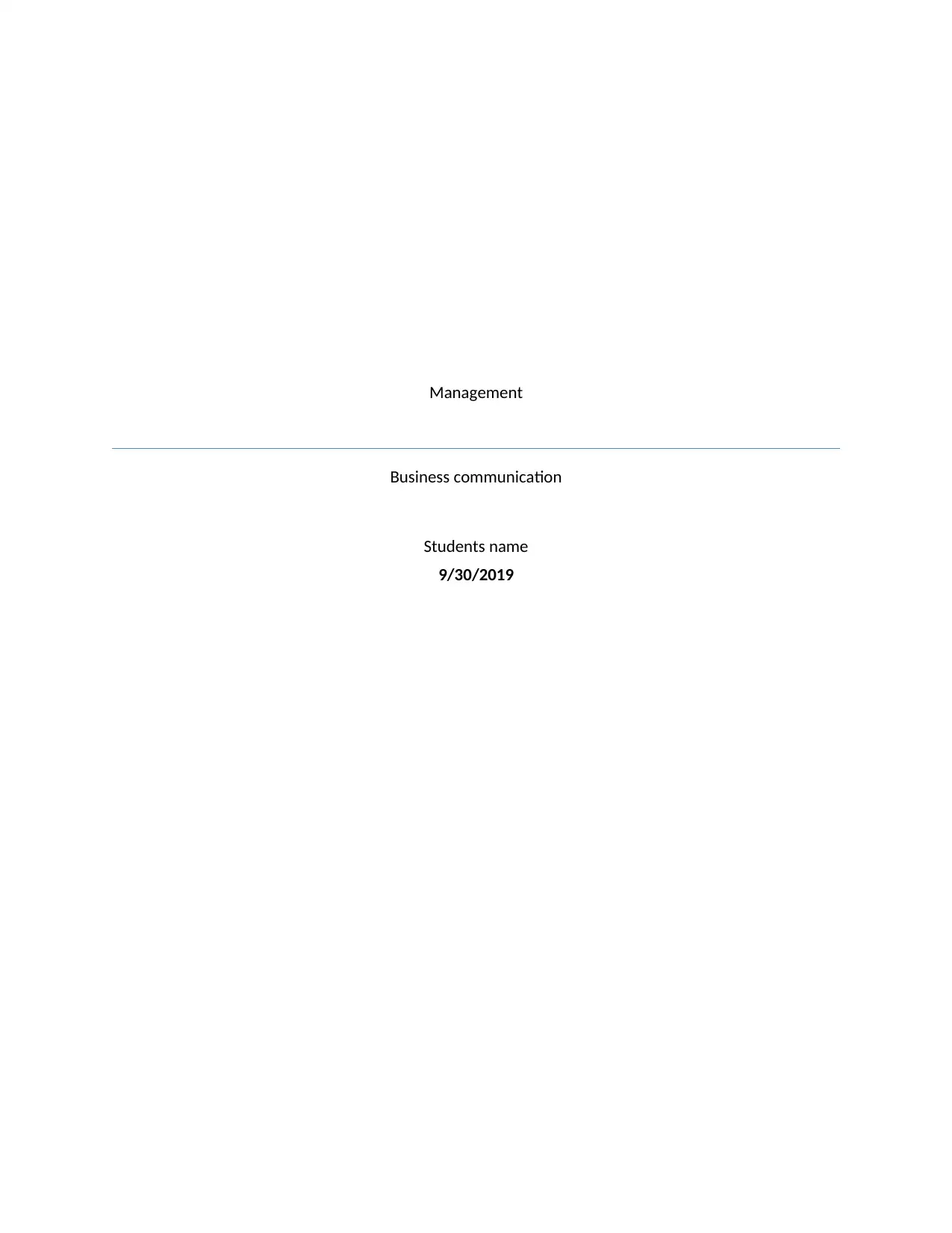
Management
Business communication
Students name
9/30/2019
Business communication
Students name
9/30/2019
Secure Best Marks with AI Grader
Need help grading? Try our AI Grader for instant feedback on your assignments.
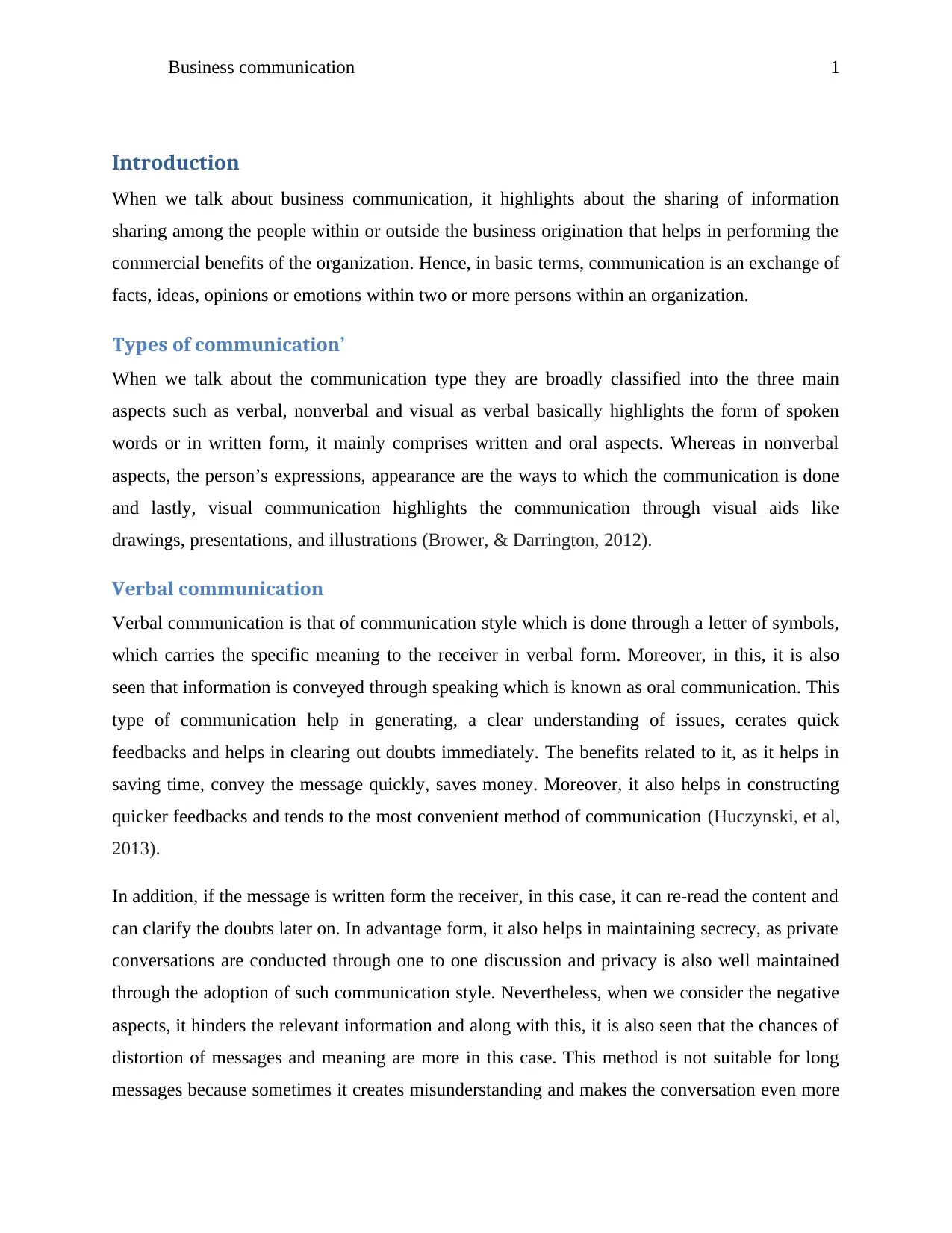
Business communication 1
Introduction
When we talk about business communication, it highlights about the sharing of information
sharing among the people within or outside the business origination that helps in performing the
commercial benefits of the organization. Hence, in basic terms, communication is an exchange of
facts, ideas, opinions or emotions within two or more persons within an organization.
Types of communication’
When we talk about the communication type they are broadly classified into the three main
aspects such as verbal, nonverbal and visual as verbal basically highlights the form of spoken
words or in written form, it mainly comprises written and oral aspects. Whereas in nonverbal
aspects, the person’s expressions, appearance are the ways to which the communication is done
and lastly, visual communication highlights the communication through visual aids like
drawings, presentations, and illustrations (Brower, & Darrington, 2012).
Verbal communication
Verbal communication is that of communication style which is done through a letter of symbols,
which carries the specific meaning to the receiver in verbal form. Moreover, in this, it is also
seen that information is conveyed through speaking which is known as oral communication. This
type of communication help in generating, a clear understanding of issues, cerates quick
feedbacks and helps in clearing out doubts immediately. The benefits related to it, as it helps in
saving time, convey the message quickly, saves money. Moreover, it also helps in constructing
quicker feedbacks and tends to the most convenient method of communication (Huczynski, et al,
2013).
In addition, if the message is written form the receiver, in this case, it can re-read the content and
can clarify the doubts later on. In advantage form, it also helps in maintaining secrecy, as private
conversations are conducted through one to one discussion and privacy is also well maintained
through the adoption of such communication style. Nevertheless, when we consider the negative
aspects, it hinders the relevant information and along with this, it is also seen that the chances of
distortion of messages and meaning are more in this case. This method is not suitable for long
messages because sometimes it creates misunderstanding and makes the conversation even more
Introduction
When we talk about business communication, it highlights about the sharing of information
sharing among the people within or outside the business origination that helps in performing the
commercial benefits of the organization. Hence, in basic terms, communication is an exchange of
facts, ideas, opinions or emotions within two or more persons within an organization.
Types of communication’
When we talk about the communication type they are broadly classified into the three main
aspects such as verbal, nonverbal and visual as verbal basically highlights the form of spoken
words or in written form, it mainly comprises written and oral aspects. Whereas in nonverbal
aspects, the person’s expressions, appearance are the ways to which the communication is done
and lastly, visual communication highlights the communication through visual aids like
drawings, presentations, and illustrations (Brower, & Darrington, 2012).
Verbal communication
Verbal communication is that of communication style which is done through a letter of symbols,
which carries the specific meaning to the receiver in verbal form. Moreover, in this, it is also
seen that information is conveyed through speaking which is known as oral communication. This
type of communication help in generating, a clear understanding of issues, cerates quick
feedbacks and helps in clearing out doubts immediately. The benefits related to it, as it helps in
saving time, convey the message quickly, saves money. Moreover, it also helps in constructing
quicker feedbacks and tends to the most convenient method of communication (Huczynski, et al,
2013).
In addition, if the message is written form the receiver, in this case, it can re-read the content and
can clarify the doubts later on. In advantage form, it also helps in maintaining secrecy, as private
conversations are conducted through one to one discussion and privacy is also well maintained
through the adoption of such communication style. Nevertheless, when we consider the negative
aspects, it hinders the relevant information and along with this, it is also seen that the chances of
distortion of messages and meaning are more in this case. This method is not suitable for long
messages because sometimes it creates misunderstanding and makes the conversation even more
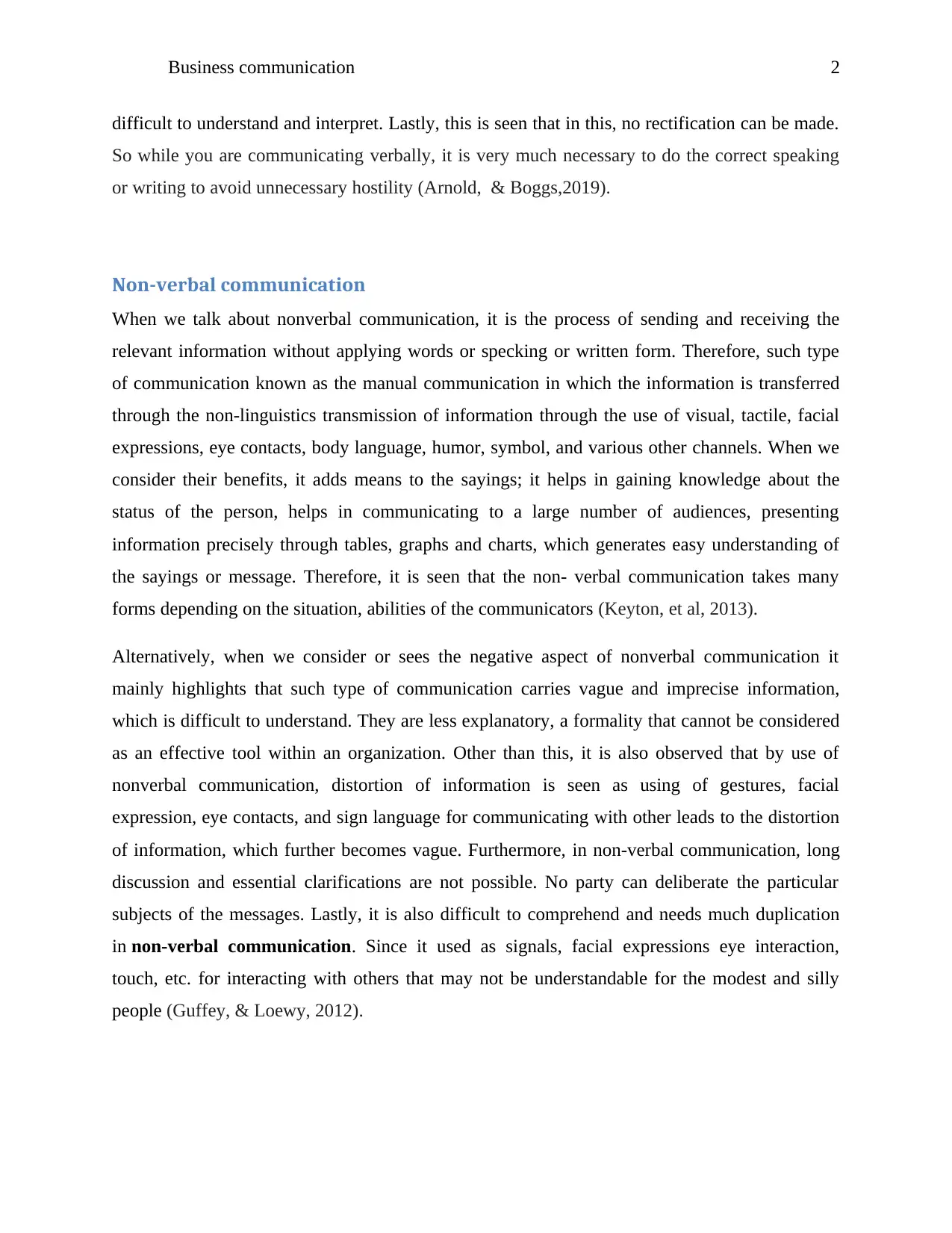
Business communication 2
difficult to understand and interpret. Lastly, this is seen that in this, no rectification can be made.
So while you are communicating verbally, it is very much necessary to do the correct speaking
or writing to avoid unnecessary hostility (Arnold, & Boggs,2019).
Non-verbal communication
When we talk about nonverbal communication, it is the process of sending and receiving the
relevant information without applying words or specking or written form. Therefore, such type
of communication known as the manual communication in which the information is transferred
through the non-linguistics transmission of information through the use of visual, tactile, facial
expressions, eye contacts, body language, humor, symbol, and various other channels. When we
consider their benefits, it adds means to the sayings; it helps in gaining knowledge about the
status of the person, helps in communicating to a large number of audiences, presenting
information precisely through tables, graphs and charts, which generates easy understanding of
the sayings or message. Therefore, it is seen that the non- verbal communication takes many
forms depending on the situation, abilities of the communicators (Keyton, et al, 2013).
Alternatively, when we consider or sees the negative aspect of nonverbal communication it
mainly highlights that such type of communication carries vague and imprecise information,
which is difficult to understand. They are less explanatory, a formality that cannot be considered
as an effective tool within an organization. Other than this, it is also observed that by use of
nonverbal communication, distortion of information is seen as using of gestures, facial
expression, eye contacts, and sign language for communicating with other leads to the distortion
of information, which further becomes vague. Furthermore, in non-verbal communication, long
discussion and essential clarifications are not possible. No party can deliberate the particular
subjects of the messages. Lastly, it is also difficult to comprehend and needs much duplication
in non-verbal communication. Since it used as signals, facial expressions eye interaction,
touch, etc. for interacting with others that may not be understandable for the modest and silly
people (Guffey, & Loewy, 2012).
difficult to understand and interpret. Lastly, this is seen that in this, no rectification can be made.
So while you are communicating verbally, it is very much necessary to do the correct speaking
or writing to avoid unnecessary hostility (Arnold, & Boggs,2019).
Non-verbal communication
When we talk about nonverbal communication, it is the process of sending and receiving the
relevant information without applying words or specking or written form. Therefore, such type
of communication known as the manual communication in which the information is transferred
through the non-linguistics transmission of information through the use of visual, tactile, facial
expressions, eye contacts, body language, humor, symbol, and various other channels. When we
consider their benefits, it adds means to the sayings; it helps in gaining knowledge about the
status of the person, helps in communicating to a large number of audiences, presenting
information precisely through tables, graphs and charts, which generates easy understanding of
the sayings or message. Therefore, it is seen that the non- verbal communication takes many
forms depending on the situation, abilities of the communicators (Keyton, et al, 2013).
Alternatively, when we consider or sees the negative aspect of nonverbal communication it
mainly highlights that such type of communication carries vague and imprecise information,
which is difficult to understand. They are less explanatory, a formality that cannot be considered
as an effective tool within an organization. Other than this, it is also observed that by use of
nonverbal communication, distortion of information is seen as using of gestures, facial
expression, eye contacts, and sign language for communicating with other leads to the distortion
of information, which further becomes vague. Furthermore, in non-verbal communication, long
discussion and essential clarifications are not possible. No party can deliberate the particular
subjects of the messages. Lastly, it is also difficult to comprehend and needs much duplication
in non-verbal communication. Since it used as signals, facial expressions eye interaction,
touch, etc. for interacting with others that may not be understandable for the modest and silly
people (Guffey, & Loewy, 2012).
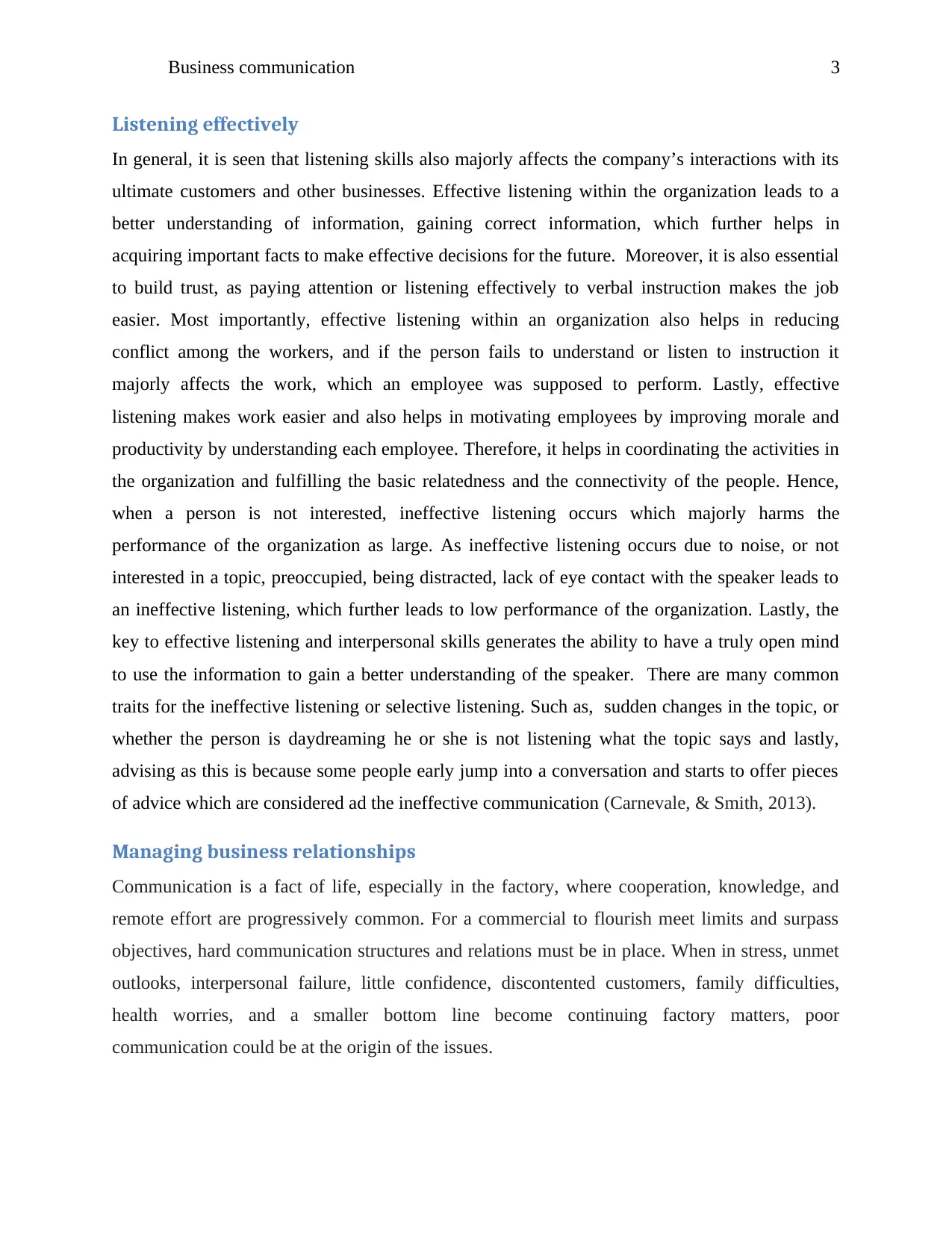
Business communication 3
Listening effectively
In general, it is seen that listening skills also majorly affects the company’s interactions with its
ultimate customers and other businesses. Effective listening within the organization leads to a
better understanding of information, gaining correct information, which further helps in
acquiring important facts to make effective decisions for the future. Moreover, it is also essential
to build trust, as paying attention or listening effectively to verbal instruction makes the job
easier. Most importantly, effective listening within an organization also helps in reducing
conflict among the workers, and if the person fails to understand or listen to instruction it
majorly affects the work, which an employee was supposed to perform. Lastly, effective
listening makes work easier and also helps in motivating employees by improving morale and
productivity by understanding each employee. Therefore, it helps in coordinating the activities in
the organization and fulfilling the basic relatedness and the connectivity of the people. Hence,
when a person is not interested, ineffective listening occurs which majorly harms the
performance of the organization as large. As ineffective listening occurs due to noise, or not
interested in a topic, preoccupied, being distracted, lack of eye contact with the speaker leads to
an ineffective listening, which further leads to low performance of the organization. Lastly, the
key to effective listening and interpersonal skills generates the ability to have a truly open mind
to use the information to gain a better understanding of the speaker. There are many common
traits for the ineffective listening or selective listening. Such as, sudden changes in the topic, or
whether the person is daydreaming he or she is not listening what the topic says and lastly,
advising as this is because some people early jump into a conversation and starts to offer pieces
of advice which are considered ad the ineffective communication (Carnevale, & Smith, 2013).
Managing business relationships
Communication is a fact of life, especially in the factory, where cooperation, knowledge, and
remote effort are progressively common. For a commercial to flourish meet limits and surpass
objectives, hard communication structures and relations must be in place. When in stress, unmet
outlooks, interpersonal failure, little confidence, discontented customers, family difficulties,
health worries, and a smaller bottom line become continuing factory matters, poor
communication could be at the origin of the issues.
Listening effectively
In general, it is seen that listening skills also majorly affects the company’s interactions with its
ultimate customers and other businesses. Effective listening within the organization leads to a
better understanding of information, gaining correct information, which further helps in
acquiring important facts to make effective decisions for the future. Moreover, it is also essential
to build trust, as paying attention or listening effectively to verbal instruction makes the job
easier. Most importantly, effective listening within an organization also helps in reducing
conflict among the workers, and if the person fails to understand or listen to instruction it
majorly affects the work, which an employee was supposed to perform. Lastly, effective
listening makes work easier and also helps in motivating employees by improving morale and
productivity by understanding each employee. Therefore, it helps in coordinating the activities in
the organization and fulfilling the basic relatedness and the connectivity of the people. Hence,
when a person is not interested, ineffective listening occurs which majorly harms the
performance of the organization as large. As ineffective listening occurs due to noise, or not
interested in a topic, preoccupied, being distracted, lack of eye contact with the speaker leads to
an ineffective listening, which further leads to low performance of the organization. Lastly, the
key to effective listening and interpersonal skills generates the ability to have a truly open mind
to use the information to gain a better understanding of the speaker. There are many common
traits for the ineffective listening or selective listening. Such as, sudden changes in the topic, or
whether the person is daydreaming he or she is not listening what the topic says and lastly,
advising as this is because some people early jump into a conversation and starts to offer pieces
of advice which are considered ad the ineffective communication (Carnevale, & Smith, 2013).
Managing business relationships
Communication is a fact of life, especially in the factory, where cooperation, knowledge, and
remote effort are progressively common. For a commercial to flourish meet limits and surpass
objectives, hard communication structures and relations must be in place. When in stress, unmet
outlooks, interpersonal failure, little confidence, discontented customers, family difficulties,
health worries, and a smaller bottom line become continuing factory matters, poor
communication could be at the origin of the issues.
Secure Best Marks with AI Grader
Need help grading? Try our AI Grader for instant feedback on your assignments.
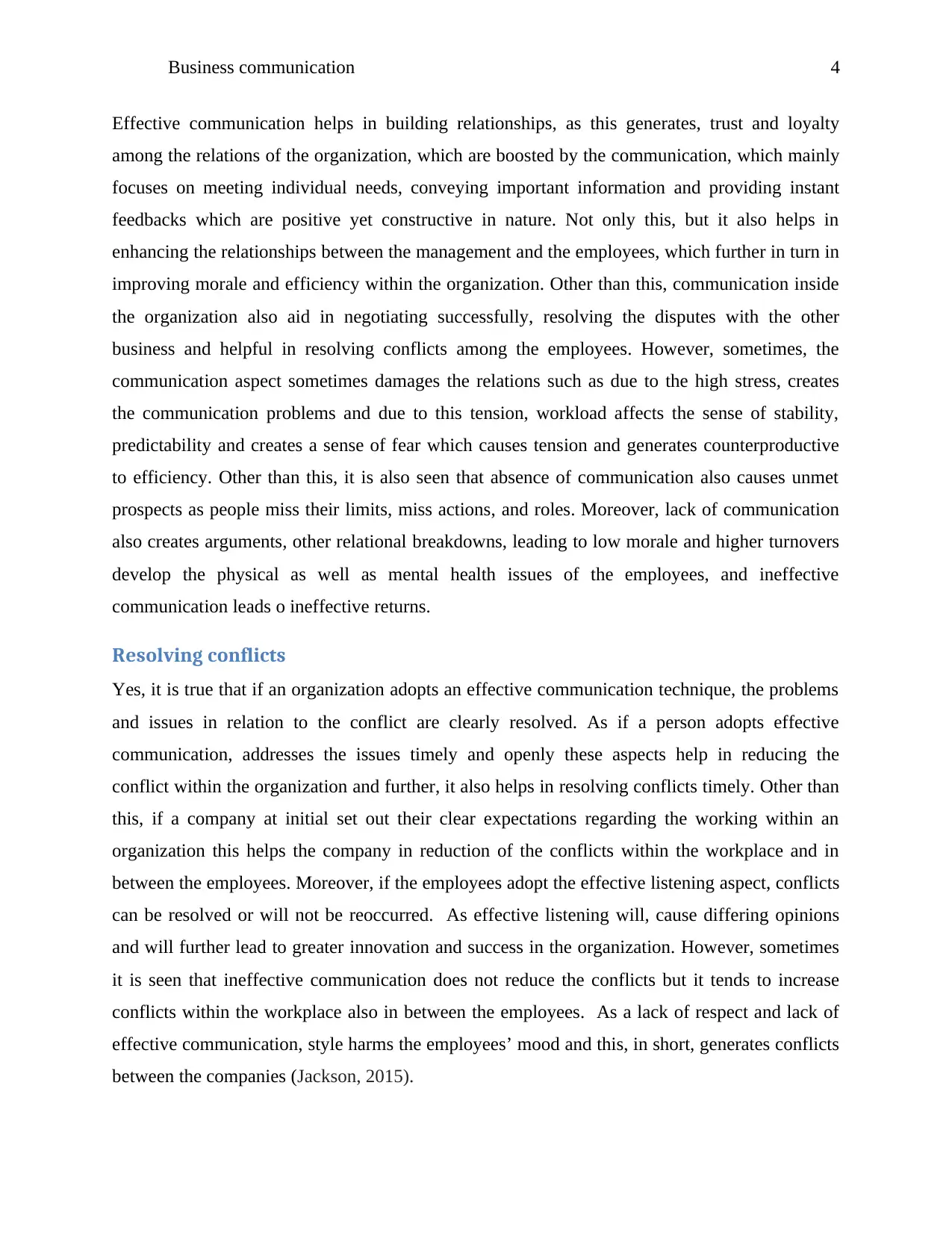
Business communication 4
Effective communication helps in building relationships, as this generates, trust and loyalty
among the relations of the organization, which are boosted by the communication, which mainly
focuses on meeting individual needs, conveying important information and providing instant
feedbacks which are positive yet constructive in nature. Not only this, but it also helps in
enhancing the relationships between the management and the employees, which further in turn in
improving morale and efficiency within the organization. Other than this, communication inside
the organization also aid in negotiating successfully, resolving the disputes with the other
business and helpful in resolving conflicts among the employees. However, sometimes, the
communication aspect sometimes damages the relations such as due to the high stress, creates
the communication problems and due to this tension, workload affects the sense of stability,
predictability and creates a sense of fear which causes tension and generates counterproductive
to efficiency. Other than this, it is also seen that absence of communication also causes unmet
prospects as people miss their limits, miss actions, and roles. Moreover, lack of communication
also creates arguments, other relational breakdowns, leading to low morale and higher turnovers
develop the physical as well as mental health issues of the employees, and ineffective
communication leads o ineffective returns.
Resolving conflicts
Yes, it is true that if an organization adopts an effective communication technique, the problems
and issues in relation to the conflict are clearly resolved. As if a person adopts effective
communication, addresses the issues timely and openly these aspects help in reducing the
conflict within the organization and further, it also helps in resolving conflicts timely. Other than
this, if a company at initial set out their clear expectations regarding the working within an
organization this helps the company in reduction of the conflicts within the workplace and in
between the employees. Moreover, if the employees adopt the effective listening aspect, conflicts
can be resolved or will not be reoccurred. As effective listening will, cause differing opinions
and will further lead to greater innovation and success in the organization. However, sometimes
it is seen that ineffective communication does not reduce the conflicts but it tends to increase
conflicts within the workplace also in between the employees. As a lack of respect and lack of
effective communication, style harms the employees’ mood and this, in short, generates conflicts
between the companies (Jackson, 2015).
Effective communication helps in building relationships, as this generates, trust and loyalty
among the relations of the organization, which are boosted by the communication, which mainly
focuses on meeting individual needs, conveying important information and providing instant
feedbacks which are positive yet constructive in nature. Not only this, but it also helps in
enhancing the relationships between the management and the employees, which further in turn in
improving morale and efficiency within the organization. Other than this, communication inside
the organization also aid in negotiating successfully, resolving the disputes with the other
business and helpful in resolving conflicts among the employees. However, sometimes, the
communication aspect sometimes damages the relations such as due to the high stress, creates
the communication problems and due to this tension, workload affects the sense of stability,
predictability and creates a sense of fear which causes tension and generates counterproductive
to efficiency. Other than this, it is also seen that absence of communication also causes unmet
prospects as people miss their limits, miss actions, and roles. Moreover, lack of communication
also creates arguments, other relational breakdowns, leading to low morale and higher turnovers
develop the physical as well as mental health issues of the employees, and ineffective
communication leads o ineffective returns.
Resolving conflicts
Yes, it is true that if an organization adopts an effective communication technique, the problems
and issues in relation to the conflict are clearly resolved. As if a person adopts effective
communication, addresses the issues timely and openly these aspects help in reducing the
conflict within the organization and further, it also helps in resolving conflicts timely. Other than
this, if a company at initial set out their clear expectations regarding the working within an
organization this helps the company in reduction of the conflicts within the workplace and in
between the employees. Moreover, if the employees adopt the effective listening aspect, conflicts
can be resolved or will not be reoccurred. As effective listening will, cause differing opinions
and will further lead to greater innovation and success in the organization. However, sometimes
it is seen that ineffective communication does not reduce the conflicts but it tends to increase
conflicts within the workplace also in between the employees. As a lack of respect and lack of
effective communication, style harms the employees’ mood and this, in short, generates conflicts
between the companies (Jackson, 2015).
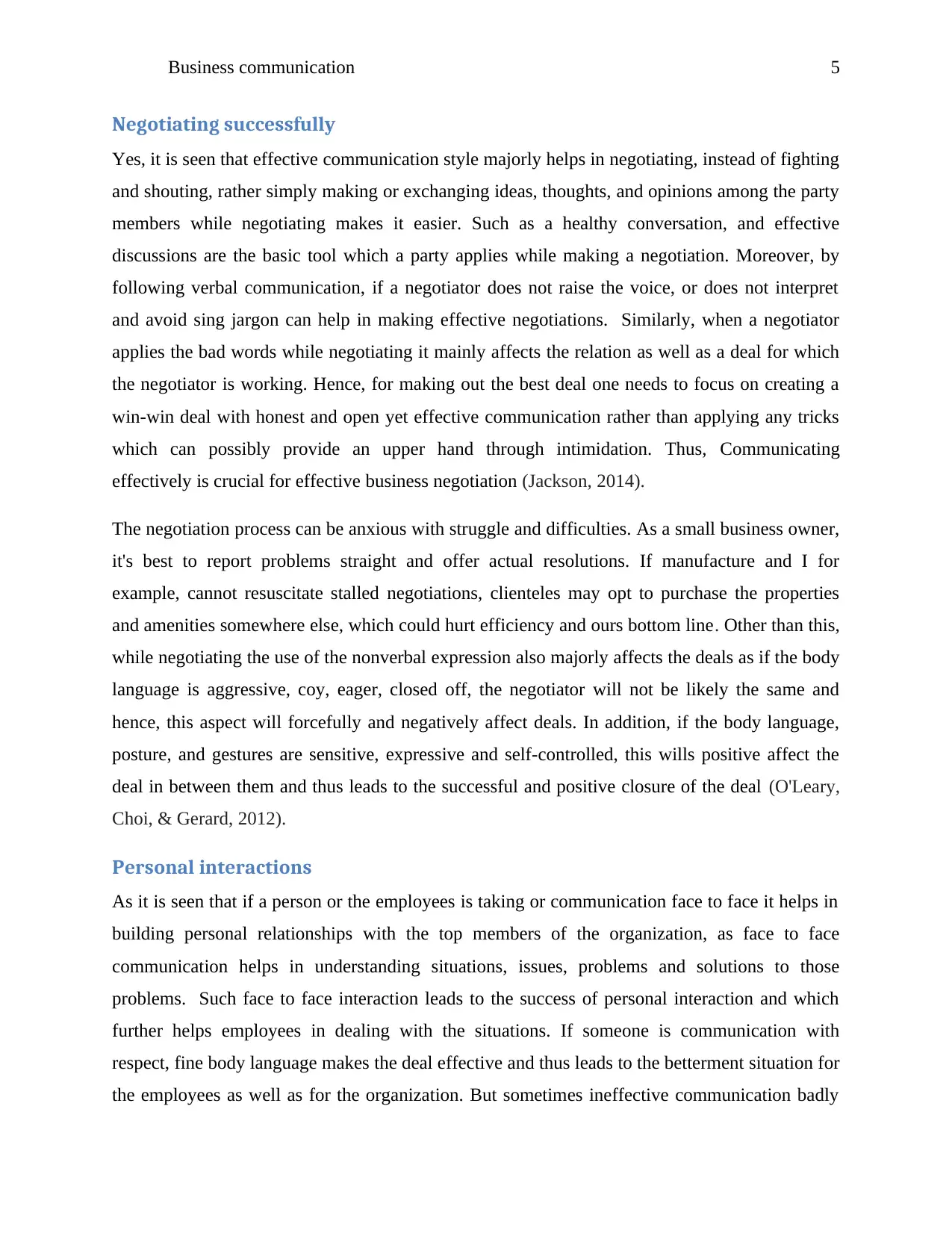
Business communication 5
Negotiating successfully
Yes, it is seen that effective communication style majorly helps in negotiating, instead of fighting
and shouting, rather simply making or exchanging ideas, thoughts, and opinions among the party
members while negotiating makes it easier. Such as a healthy conversation, and effective
discussions are the basic tool which a party applies while making a negotiation. Moreover, by
following verbal communication, if a negotiator does not raise the voice, or does not interpret
and avoid sing jargon can help in making effective negotiations. Similarly, when a negotiator
applies the bad words while negotiating it mainly affects the relation as well as a deal for which
the negotiator is working. Hence, for making out the best deal one needs to focus on creating a
win-win deal with honest and open yet effective communication rather than applying any tricks
which can possibly provide an upper hand through intimidation. Thus, Communicating
effectively is crucial for effective business negotiation (Jackson, 2014).
The negotiation process can be anxious with struggle and difficulties. As a small business owner,
it's best to report problems straight and offer actual resolutions. If manufacture and I for
example, cannot resuscitate stalled negotiations, clienteles may opt to purchase the properties
and amenities somewhere else, which could hurt efficiency and ours bottom line. Other than this,
while negotiating the use of the nonverbal expression also majorly affects the deals as if the body
language is aggressive, coy, eager, closed off, the negotiator will not be likely the same and
hence, this aspect will forcefully and negatively affect deals. In addition, if the body language,
posture, and gestures are sensitive, expressive and self-controlled, this wills positive affect the
deal in between them and thus leads to the successful and positive closure of the deal (O'Leary,
Choi, & Gerard, 2012).
Personal interactions
As it is seen that if a person or the employees is taking or communication face to face it helps in
building personal relationships with the top members of the organization, as face to face
communication helps in understanding situations, issues, problems and solutions to those
problems. Such face to face interaction leads to the success of personal interaction and which
further helps employees in dealing with the situations. If someone is communication with
respect, fine body language makes the deal effective and thus leads to the betterment situation for
the employees as well as for the organization. But sometimes ineffective communication badly
Negotiating successfully
Yes, it is seen that effective communication style majorly helps in negotiating, instead of fighting
and shouting, rather simply making or exchanging ideas, thoughts, and opinions among the party
members while negotiating makes it easier. Such as a healthy conversation, and effective
discussions are the basic tool which a party applies while making a negotiation. Moreover, by
following verbal communication, if a negotiator does not raise the voice, or does not interpret
and avoid sing jargon can help in making effective negotiations. Similarly, when a negotiator
applies the bad words while negotiating it mainly affects the relation as well as a deal for which
the negotiator is working. Hence, for making out the best deal one needs to focus on creating a
win-win deal with honest and open yet effective communication rather than applying any tricks
which can possibly provide an upper hand through intimidation. Thus, Communicating
effectively is crucial for effective business negotiation (Jackson, 2014).
The negotiation process can be anxious with struggle and difficulties. As a small business owner,
it's best to report problems straight and offer actual resolutions. If manufacture and I for
example, cannot resuscitate stalled negotiations, clienteles may opt to purchase the properties
and amenities somewhere else, which could hurt efficiency and ours bottom line. Other than this,
while negotiating the use of the nonverbal expression also majorly affects the deals as if the body
language is aggressive, coy, eager, closed off, the negotiator will not be likely the same and
hence, this aspect will forcefully and negatively affect deals. In addition, if the body language,
posture, and gestures are sensitive, expressive and self-controlled, this wills positive affect the
deal in between them and thus leads to the successful and positive closure of the deal (O'Leary,
Choi, & Gerard, 2012).
Personal interactions
As it is seen that if a person or the employees is taking or communication face to face it helps in
building personal relationships with the top members of the organization, as face to face
communication helps in understanding situations, issues, problems and solutions to those
problems. Such face to face interaction leads to the success of personal interaction and which
further helps employees in dealing with the situations. If someone is communication with
respect, fine body language makes the deal effective and thus leads to the betterment situation for
the employees as well as for the organization. But sometimes ineffective communication badly
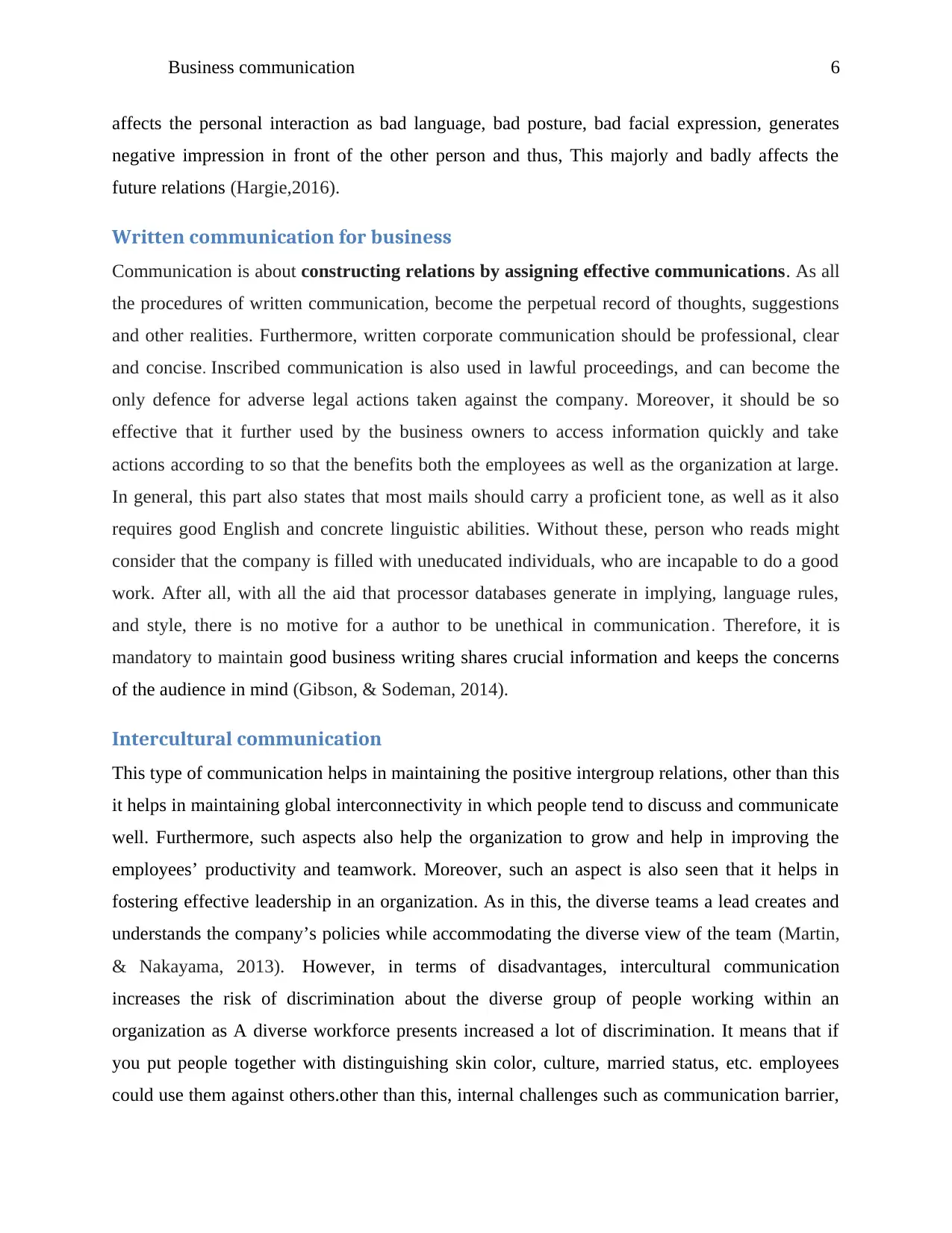
Business communication 6
affects the personal interaction as bad language, bad posture, bad facial expression, generates
negative impression in front of the other person and thus, This majorly and badly affects the
future relations (Hargie,2016).
Written communication for business
Communication is about constructing relations by assigning effective communications. As all
the procedures of written communication, become the perpetual record of thoughts, suggestions
and other realities. Furthermore, written corporate communication should be professional, clear
and concise. Inscribed communication is also used in lawful proceedings, and can become the
only defence for adverse legal actions taken against the company. Moreover, it should be so
effective that it further used by the business owners to access information quickly and take
actions according to so that the benefits both the employees as well as the organization at large.
In general, this part also states that most mails should carry a proficient tone, as well as it also
requires good English and concrete linguistic abilities. Without these, person who reads might
consider that the company is filled with uneducated individuals, who are incapable to do a good
work. After all, with all the aid that processor databases generate in implying, language rules,
and style, there is no motive for a author to be unethical in communication. Therefore, it is
mandatory to maintain good business writing shares crucial information and keeps the concerns
of the audience in mind (Gibson, & Sodeman, 2014).
Intercultural communication
This type of communication helps in maintaining the positive intergroup relations, other than this
it helps in maintaining global interconnectivity in which people tend to discuss and communicate
well. Furthermore, such aspects also help the organization to grow and help in improving the
employees’ productivity and teamwork. Moreover, such an aspect is also seen that it helps in
fostering effective leadership in an organization. As in this, the diverse teams a lead creates and
understands the company’s policies while accommodating the diverse view of the team (Martin,
& Nakayama, 2013). However, in terms of disadvantages, intercultural communication
increases the risk of discrimination about the diverse group of people working within an
organization as A diverse workforce presents increased a lot of discrimination. It means that if
you put people together with distinguishing skin color, culture, married status, etc. employees
could use them against others.other than this, internal challenges such as communication barrier,
affects the personal interaction as bad language, bad posture, bad facial expression, generates
negative impression in front of the other person and thus, This majorly and badly affects the
future relations (Hargie,2016).
Written communication for business
Communication is about constructing relations by assigning effective communications. As all
the procedures of written communication, become the perpetual record of thoughts, suggestions
and other realities. Furthermore, written corporate communication should be professional, clear
and concise. Inscribed communication is also used in lawful proceedings, and can become the
only defence for adverse legal actions taken against the company. Moreover, it should be so
effective that it further used by the business owners to access information quickly and take
actions according to so that the benefits both the employees as well as the organization at large.
In general, this part also states that most mails should carry a proficient tone, as well as it also
requires good English and concrete linguistic abilities. Without these, person who reads might
consider that the company is filled with uneducated individuals, who are incapable to do a good
work. After all, with all the aid that processor databases generate in implying, language rules,
and style, there is no motive for a author to be unethical in communication. Therefore, it is
mandatory to maintain good business writing shares crucial information and keeps the concerns
of the audience in mind (Gibson, & Sodeman, 2014).
Intercultural communication
This type of communication helps in maintaining the positive intergroup relations, other than this
it helps in maintaining global interconnectivity in which people tend to discuss and communicate
well. Furthermore, such aspects also help the organization to grow and help in improving the
employees’ productivity and teamwork. Moreover, such an aspect is also seen that it helps in
fostering effective leadership in an organization. As in this, the diverse teams a lead creates and
understands the company’s policies while accommodating the diverse view of the team (Martin,
& Nakayama, 2013). However, in terms of disadvantages, intercultural communication
increases the risk of discrimination about the diverse group of people working within an
organization as A diverse workforce presents increased a lot of discrimination. It means that if
you put people together with distinguishing skin color, culture, married status, etc. employees
could use them against others.other than this, internal challenges such as communication barrier,
Paraphrase This Document
Need a fresh take? Get an instant paraphrase of this document with our AI Paraphraser
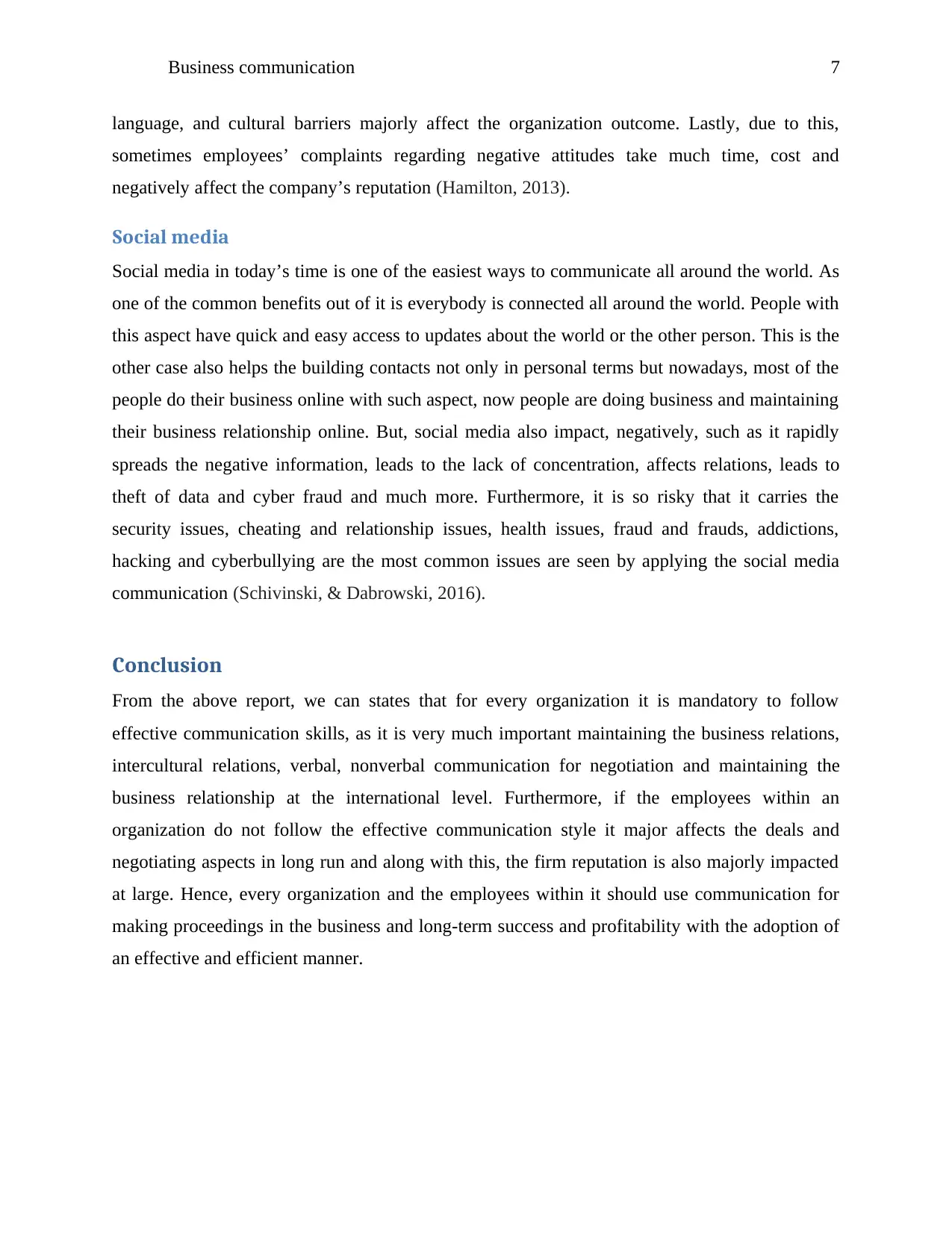
Business communication 7
language, and cultural barriers majorly affect the organization outcome. Lastly, due to this,
sometimes employees’ complaints regarding negative attitudes take much time, cost and
negatively affect the company’s reputation (Hamilton, 2013).
Social media
Social media in today’s time is one of the easiest ways to communicate all around the world. As
one of the common benefits out of it is everybody is connected all around the world. People with
this aspect have quick and easy access to updates about the world or the other person. This is the
other case also helps the building contacts not only in personal terms but nowadays, most of the
people do their business online with such aspect, now people are doing business and maintaining
their business relationship online. But, social media also impact, negatively, such as it rapidly
spreads the negative information, leads to the lack of concentration, affects relations, leads to
theft of data and cyber fraud and much more. Furthermore, it is so risky that it carries the
security issues, cheating and relationship issues, health issues, fraud and frauds, addictions,
hacking and cyberbullying are the most common issues are seen by applying the social media
communication (Schivinski, & Dabrowski, 2016).
Conclusion
From the above report, we can states that for every organization it is mandatory to follow
effective communication skills, as it is very much important maintaining the business relations,
intercultural relations, verbal, nonverbal communication for negotiation and maintaining the
business relationship at the international level. Furthermore, if the employees within an
organization do not follow the effective communication style it major affects the deals and
negotiating aspects in long run and along with this, the firm reputation is also majorly impacted
at large. Hence, every organization and the employees within it should use communication for
making proceedings in the business and long-term success and profitability with the adoption of
an effective and efficient manner.
language, and cultural barriers majorly affect the organization outcome. Lastly, due to this,
sometimes employees’ complaints regarding negative attitudes take much time, cost and
negatively affect the company’s reputation (Hamilton, 2013).
Social media
Social media in today’s time is one of the easiest ways to communicate all around the world. As
one of the common benefits out of it is everybody is connected all around the world. People with
this aspect have quick and easy access to updates about the world or the other person. This is the
other case also helps the building contacts not only in personal terms but nowadays, most of the
people do their business online with such aspect, now people are doing business and maintaining
their business relationship online. But, social media also impact, negatively, such as it rapidly
spreads the negative information, leads to the lack of concentration, affects relations, leads to
theft of data and cyber fraud and much more. Furthermore, it is so risky that it carries the
security issues, cheating and relationship issues, health issues, fraud and frauds, addictions,
hacking and cyberbullying are the most common issues are seen by applying the social media
communication (Schivinski, & Dabrowski, 2016).
Conclusion
From the above report, we can states that for every organization it is mandatory to follow
effective communication skills, as it is very much important maintaining the business relations,
intercultural relations, verbal, nonverbal communication for negotiation and maintaining the
business relationship at the international level. Furthermore, if the employees within an
organization do not follow the effective communication style it major affects the deals and
negotiating aspects in long run and along with this, the firm reputation is also majorly impacted
at large. Hence, every organization and the employees within it should use communication for
making proceedings in the business and long-term success and profitability with the adoption of
an effective and efficient manner.
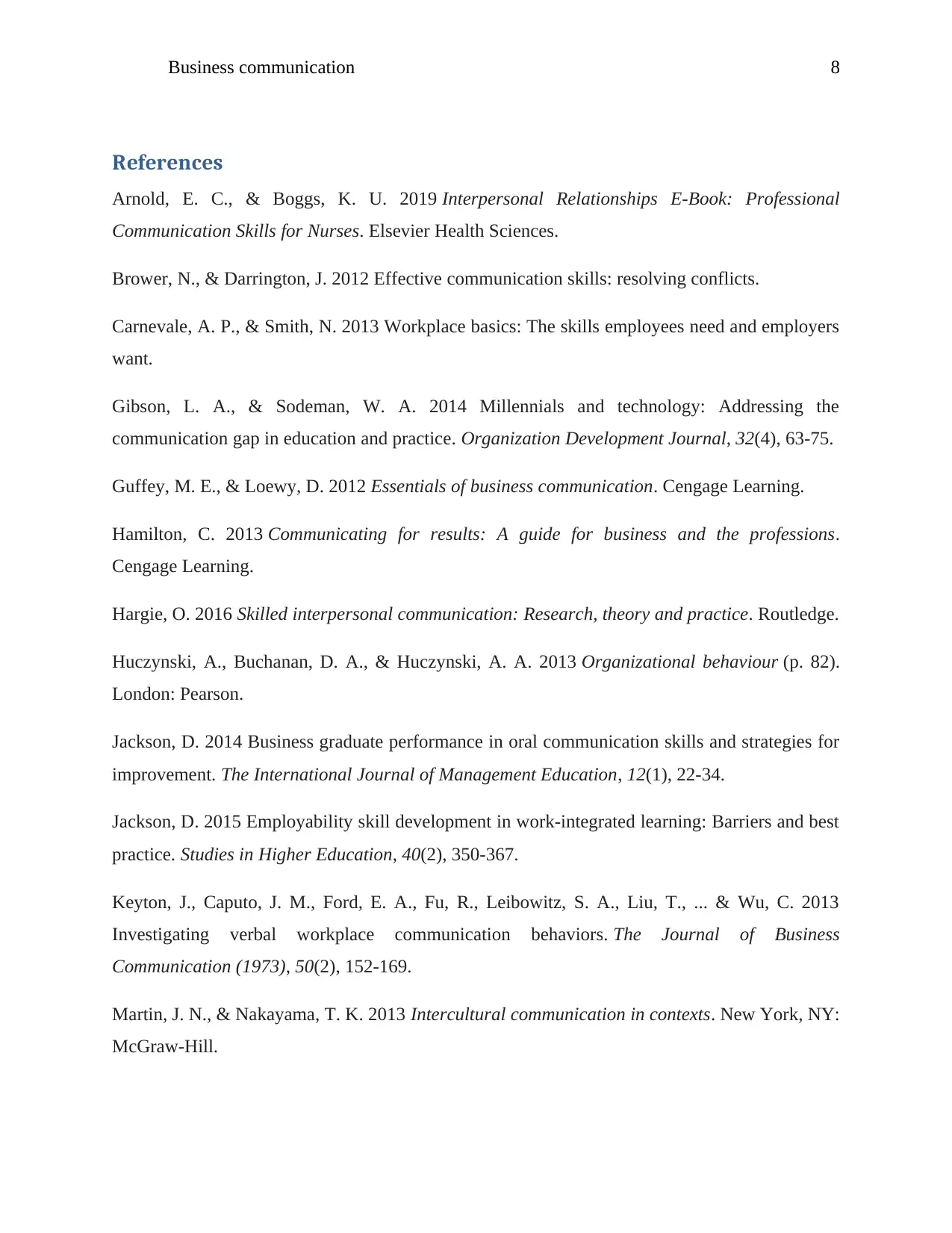
Business communication 8
References
Arnold, E. C., & Boggs, K. U. 2019 Interpersonal Relationships E-Book: Professional
Communication Skills for Nurses. Elsevier Health Sciences.
Brower, N., & Darrington, J. 2012 Effective communication skills: resolving conflicts.
Carnevale, A. P., & Smith, N. 2013 Workplace basics: The skills employees need and employers
want.
Gibson, L. A., & Sodeman, W. A. 2014 Millennials and technology: Addressing the
communication gap in education and practice. Organization Development Journal, 32(4), 63-75.
Guffey, M. E., & Loewy, D. 2012 Essentials of business communication. Cengage Learning.
Hamilton, C. 2013 Communicating for results: A guide for business and the professions.
Cengage Learning.
Hargie, O. 2016 Skilled interpersonal communication: Research, theory and practice. Routledge.
Huczynski, A., Buchanan, D. A., & Huczynski, A. A. 2013 Organizational behaviour (p. 82).
London: Pearson.
Jackson, D. 2014 Business graduate performance in oral communication skills and strategies for
improvement. The International Journal of Management Education, 12(1), 22-34.
Jackson, D. 2015 Employability skill development in work-integrated learning: Barriers and best
practice. Studies in Higher Education, 40(2), 350-367.
Keyton, J., Caputo, J. M., Ford, E. A., Fu, R., Leibowitz, S. A., Liu, T., ... & Wu, C. 2013
Investigating verbal workplace communication behaviors. The Journal of Business
Communication (1973), 50(2), 152-169.
Martin, J. N., & Nakayama, T. K. 2013 Intercultural communication in contexts. New York, NY:
McGraw-Hill.
References
Arnold, E. C., & Boggs, K. U. 2019 Interpersonal Relationships E-Book: Professional
Communication Skills for Nurses. Elsevier Health Sciences.
Brower, N., & Darrington, J. 2012 Effective communication skills: resolving conflicts.
Carnevale, A. P., & Smith, N. 2013 Workplace basics: The skills employees need and employers
want.
Gibson, L. A., & Sodeman, W. A. 2014 Millennials and technology: Addressing the
communication gap in education and practice. Organization Development Journal, 32(4), 63-75.
Guffey, M. E., & Loewy, D. 2012 Essentials of business communication. Cengage Learning.
Hamilton, C. 2013 Communicating for results: A guide for business and the professions.
Cengage Learning.
Hargie, O. 2016 Skilled interpersonal communication: Research, theory and practice. Routledge.
Huczynski, A., Buchanan, D. A., & Huczynski, A. A. 2013 Organizational behaviour (p. 82).
London: Pearson.
Jackson, D. 2014 Business graduate performance in oral communication skills and strategies for
improvement. The International Journal of Management Education, 12(1), 22-34.
Jackson, D. 2015 Employability skill development in work-integrated learning: Barriers and best
practice. Studies in Higher Education, 40(2), 350-367.
Keyton, J., Caputo, J. M., Ford, E. A., Fu, R., Leibowitz, S. A., Liu, T., ... & Wu, C. 2013
Investigating verbal workplace communication behaviors. The Journal of Business
Communication (1973), 50(2), 152-169.
Martin, J. N., & Nakayama, T. K. 2013 Intercultural communication in contexts. New York, NY:
McGraw-Hill.
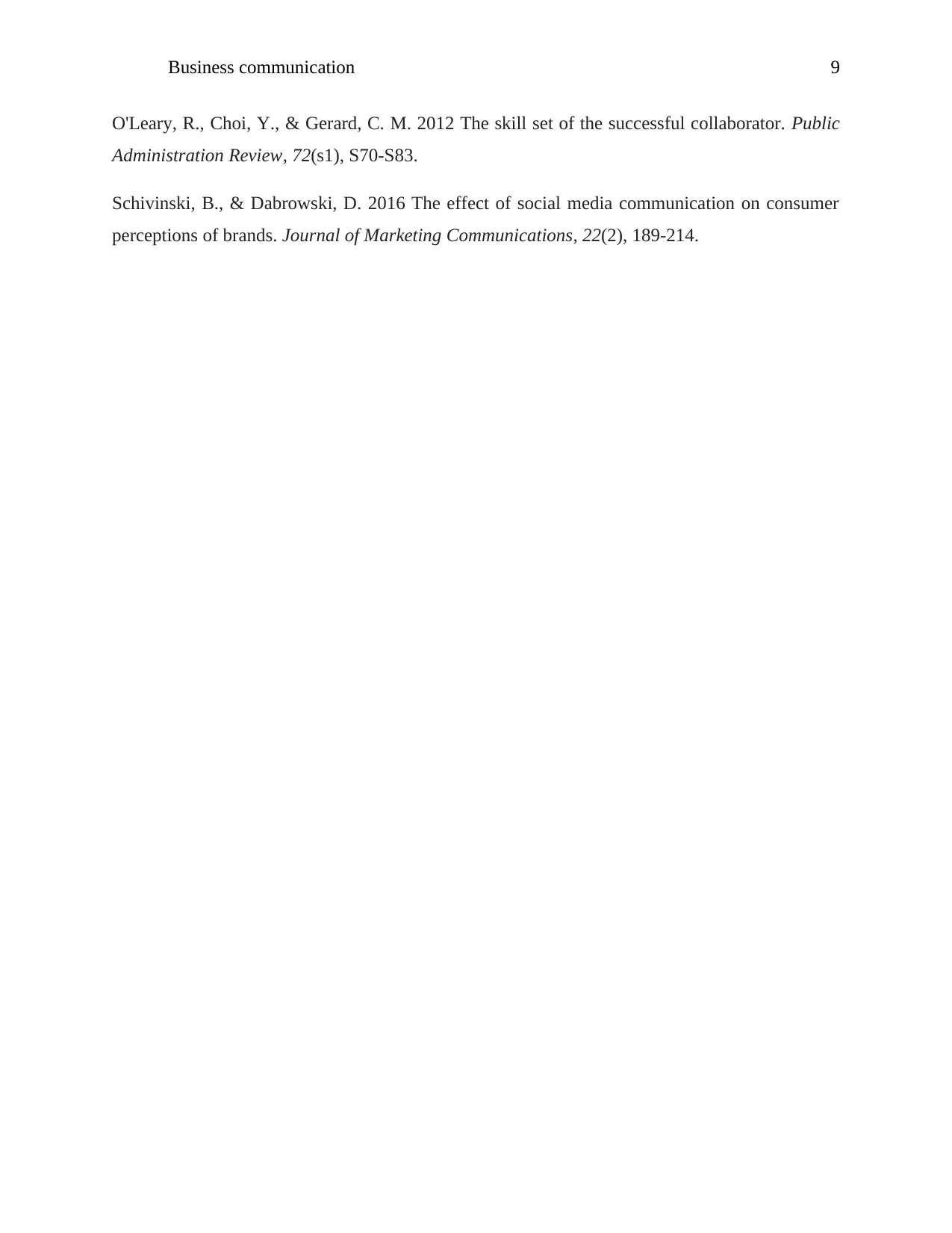
Business communication 9
O'Leary, R., Choi, Y., & Gerard, C. M. 2012 The skill set of the successful collaborator. Public
Administration Review, 72(s1), S70-S83.
Schivinski, B., & Dabrowski, D. 2016 The effect of social media communication on consumer
perceptions of brands. Journal of Marketing Communications, 22(2), 189-214.
O'Leary, R., Choi, Y., & Gerard, C. M. 2012 The skill set of the successful collaborator. Public
Administration Review, 72(s1), S70-S83.
Schivinski, B., & Dabrowski, D. 2016 The effect of social media communication on consumer
perceptions of brands. Journal of Marketing Communications, 22(2), 189-214.
1 out of 10
Related Documents
Your All-in-One AI-Powered Toolkit for Academic Success.
+13062052269
info@desklib.com
Available 24*7 on WhatsApp / Email
![[object Object]](/_next/static/media/star-bottom.7253800d.svg)
Unlock your academic potential
© 2024 | Zucol Services PVT LTD | All rights reserved.



